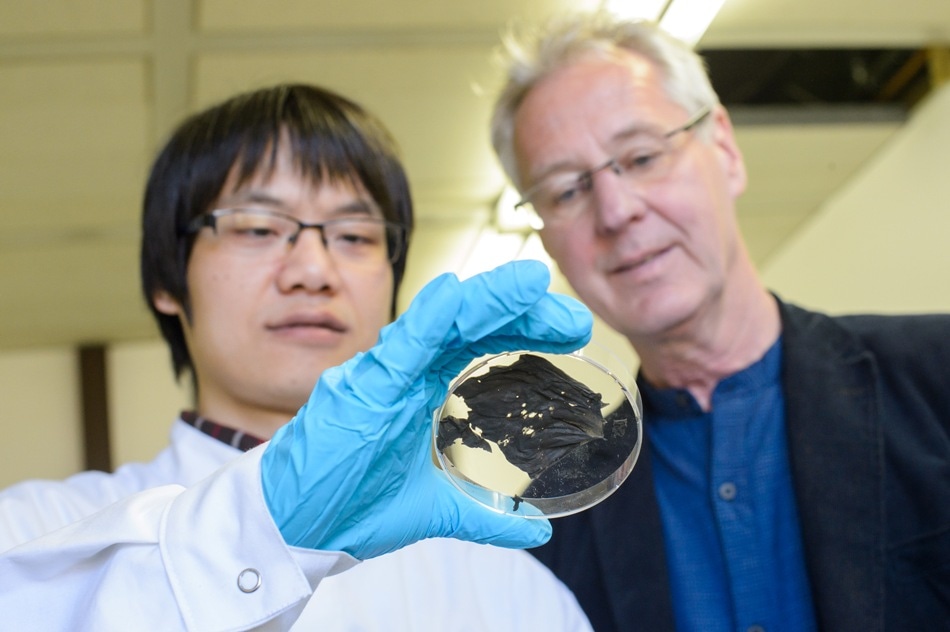Apr 7 2017
A thin nanomaterial that has superconducting properties has been developed by a team of experimental physicists headed by Professor Uwe Hartmann from Saarland University. The innovative material has the ability to levitate magnets, conduct electricity without loss, and screen magnetic fields below the temperature of about -200 °C. One fascinating feature of the research is the success of the researchers in developing superconducting nanowires that can be woven with an ultra-thin film, where the flexibility of the ultra-thin film is comparable to that of a cling film. Consequently, innovative coatings for an array of applications from medical technology to aerospace are being rendered feasible. The research was supported by the Volkswagen Foundation in its beginning stages. At present, the German Research Foundation (DFG) is funding the study.
 What looks like a pretty unremarkable piece of burnt paper is in fact an ultrathin superconductor that has been developed by the team lead by Uwe Hartmann (r.) shown here with doctoral student XianLin Zeng. Credit: Oliver Dietze
What looks like a pretty unremarkable piece of burnt paper is in fact an ultrathin superconductor that has been developed by the team lead by Uwe Hartmann (r.) shown here with doctoral student XianLin Zeng. Credit: Oliver Dietze
The researchers will display the superconducting film developed by them between 24th and 28th April at Hannover Messe (Hall 2, Stand B46). They are also exploring the possibilities of finding industrial and commercial partners for developing their system for practical use.
The study is the result of a collaborative work between Professor Uwe Hartmann’s research team from Saarland University and Professor Volker Presser from the Leibniz Institute for New Materials (INM), who is the Chair of Energy Materials at Saarland University. The outcomes of the research have been reported in various scientific journals.
The material developed by the experimental physicists from the Saarland University looks quite insignificant as it just resembles a black, charred piece of paper at the first glance. True to the saying that appearances might be deceiving, the material is a ‘superconductor’, that is, a material that has zero electrical resistance and hence has the ability to conduct electric current without any loss, normally at lower temperatures. To state in simple words, the electrons in the material have the ability to flow through the cold immobilized atomic lattice without any restraints. If there is no electrical resistance, a magnet placed very close to a cold superconductor will have the ability to effectively “see” its own mirror image in the superconducting material. Therefore, if a magnet and a superconductor are located very close to each other and cooled by using liquid nitrogen, they repel each other and the magnet starts levitating above the superconductor, where “levitation” is derived from the Latin word levitas, which means lightness. It is somewhat similar to a low-temperature version of the hoverboard in the “Back to the Future” films. However, when the temperature is very high, frictionless sliding cannot just occur.
Most of the common superconducting materials at our disposal are brittle, rigid, and dense, rendering them heavy. At present, the Saarbrücken physicists have been successful in loading a thin flexible film with superconducting properties. Fundamentally, the material is a fabric woven using high-temperature superconducting nanowires and plastic fibers.
That makes the material very pliable and adaptable—like cling film (or ‘plastic wrap’ as it’s also known). Theoretically, the material can be made to any size. And we need fewer resources than are typically required to make superconducting ceramics, so our superconducting mesh is also cheaper to fabricate.
Uwe Hartmann, Professor of Nanostructure Research and Nanotechnology from Saarland University.
The film’s lower weight is specifically favorable.
With a density of only 0.05 grams per cubic centimetre, the material is very light, weighing about a hundred times less than a conventional superconductor. This makes the material very promising for all those applications where weight is an issue, such as in space technology. There are also potential applications in medical technology.
Hartmann.
The material can be applied either as an innovative coating to enable low-temperature screening from electromagnetic fields, or it can be applied for flexible cables or to enable friction-free motion.
To be in a position to weave the innovative material, the experimental physicists utilized a method called electrospinning—normally used for producing polymeric fibers.
We force a liquid material through a very fine nozzle known as a spinneret to which a high electrical voltage has been applied. This produces nanowire filaments that are a thousand times thinner than the diameter of a human hair, typically about 300 nanometres or less. We then heat the mesh of fibres so that superconductors of the right composition are created. The superconducting material itself is typically an yttrium-barium-copper-oxide or similar compound.
Dr Michael Koblischka, a research scientist in Hartmann’s research team.
The Volkswagen Foundation provided a funding of €100,000 for this study as part of its “Experiment!” initiative, the main goal of which is to motivate curiosity-driven, blue-skies research. The positive outcomes of the research carried out by the Saarbrücken researchers indicate the benefits of such a funding. From September 2016, the German Research Foundation (DFG) has been supporting the research. A total fund amount of nearly €425,000 is to be offered over a three-year time period, and in the course of this period, the researchers will perform elaborate analyses of the properties of the nanowires.